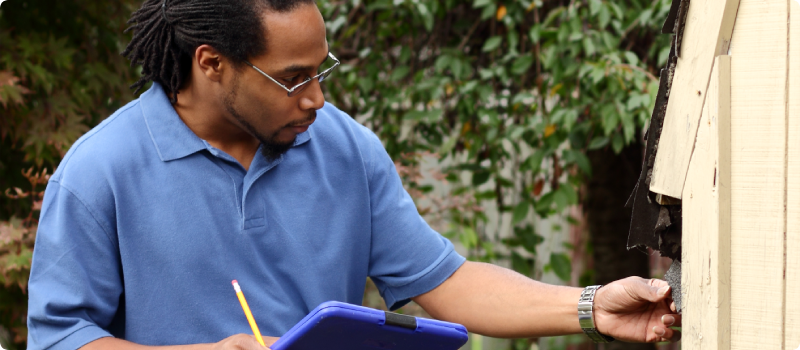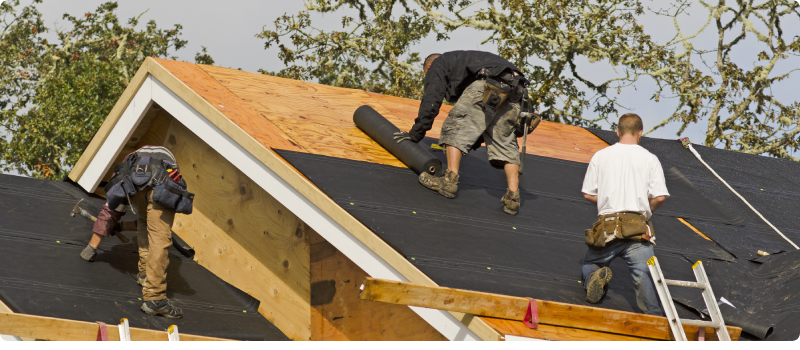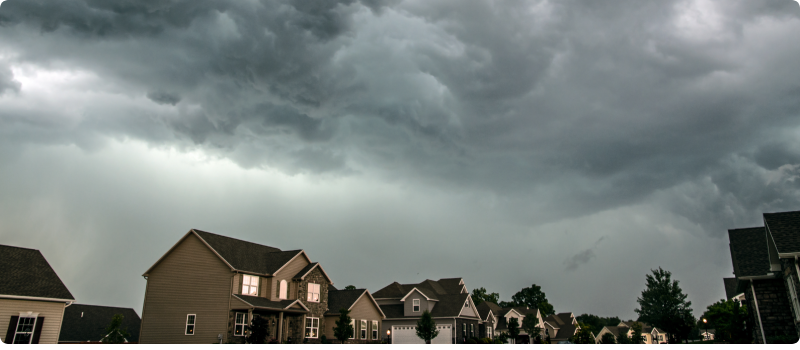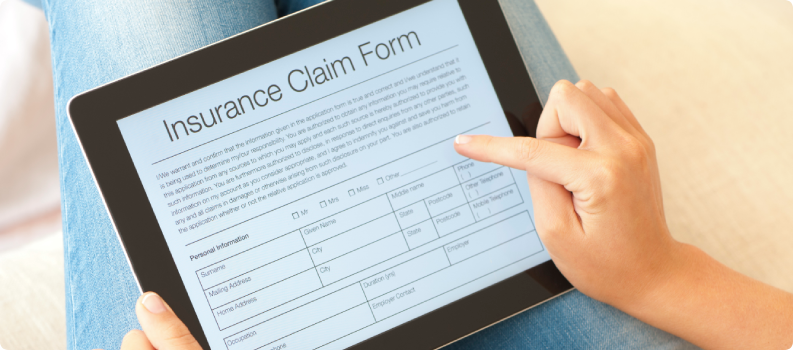Does Homeowners Insurance Cover Roof Damage?
Updated February 22, 2024 . AmFam Team
Your roof helps to keep the elements out of your home, which means maintaining it is one of your key roles as a homeowner. That means keeping it in good shape and making repairs as needed. When damage from things like wind or hail proves extensive, you might start to have questions for your insurance company.
What kind of roof damage is covered by insurance? Does homeowners insurance cover roof leaks? What about roof replacement? All are valid concerns. Roof damage insurance claims are among the most common reasons that homeowners reach out to their insurance companies. Let’s take a closer look at how your policy may handle these issues.

What Types of Roof Damage Should Homeowners Watch For?
Roof damage comes in several forms, with a variety of potential causes behind each one. Knowing exactly what you’re facing will help when you file an insurance claim. We’ll sum them up here:
- Leaks. This is arguably the most common and noticeable type of roof damage. When rain drips from your ceiling, something on the roof needs patching.
- Missing shingles. The shingles on your roof follow a pattern designed for full coverage and protection. If any of those shingles peel off from storms or other causes, the opening leaves the house vulnerable to the elements.
- Cracked or warped shingles. Shingles are tough and rigid, but they’re not invulnerable. Wind, heat, debris, and other events can dislodge or damage them. Replace them when you see them.
- Hail damage. Hail doesn’t always crack shingles, but it can leave bruises. A high enough concentration may call for total roof replacement.
As soon as you notice anything wrong, call a roof inspector to take a closer look. Once you have the details, get your insurance agent on the line to see your options. If they assess that a covered peril is responsible for the damage, your insurance may cover the losses.
What Kind of Roof Damage is Covered by Insurance?
Homeowners insurance may help pay for a damaged roof if the damage stems from a covered cause of loss.* To help explain what we mean, here are a few examples of incidents that may qualify for roof damage insurance:
- Strong winds shake a nearby tree, dislodging an old branch near the top. Part of that branch crashes down on your roof, causing damage.
- Ice dams block the gutters, causing a build-up of water that seeps into your home. Typically, there is no damage to the roof but the ensuing water damage to the interior of the home may be covered.
- Lightning strikes the roof. The resulting fire singes and warps many of the shingles.
In situations like these, you should contact your insurance company to learn exactly in which ways you’re covered. When you provide all the details, they’ll assess if the situation qualifies for coverage. Also note that insurance will not cover problems caused by wear and tear. Your roof may be hardy, but it still requires maintenance and care — and you’re responsible.

Does Home Insurance Cover Roof Replacement?
Patching holes is one thing, but does homeowners insurance cover roof replacement? It can — but, again, only if the damage comes from a covered cause of loss. The amount you’d receive for your covered damages depends on a few variables:
The Type of Roof Replacement Coverage in Your Policy
There are two types of roof replacement coverage* available, and which one applies may depend on your situation. Your roof may qualify for Replacement Cost Value (RCV) coverage. This optional coverage reimburses you for the full amount that it would cost to repair or replace your roof. This is in the event of a covered loss, and only after you pay your policy deductible.
When determining the damage to your roof, Actual Cash Value (ACV) coverage is another selectable coverage when determining your insurance needs. This coverage pays for the current actual cash value of your roof prior to the covered event occurring.
The Age and Condition of Your Roof
Age and condition have a direct relationship with ACV coverage. The payout amount is the value of the roof when it was new, minus depreciation and the policy deductible. An old roof is just not worth as much as a new one, and wear-and-tear issues only bring the cost down. This is one reason why regular maintenance is important.
Multiple layers of shingles on one roof can present structural issues to the home. If your home has several layers of shingles installed on top of each other, reach out to your American Family Insurance agent. They can guide you on what you can do to help your home qualify for roof insurance.

Does Home Insurance Cover Damage from Wind and Hail?
The most common causes of damage to roofs are wind and hail. At American Family, your homeowners insurance may cover your roof for wind and hail damage.* Whether you're covered for ACV or RCV depends on a few things.
Your roof may be eligible for RCV coverage based on its age, material type, and life expectancy. This means that if your roof is damaged from wind or hail, we may reimburse you for the full cost of repairing or replacing it. Your first payment would be the established ACV, minus the applicable policy deductible. Once the replacement of the roof has occurred, the remaining difference (also known as depreciation) will be paid to you.
Consider what it would cost you to buy a new roof for your home. It's typically a significant expense. RCV coverage may cost more than ACV coverage. If your roof is eligible for it, though, the peace of mind that you'll be fully protected may make it a smart financial choice.
Homeowners should also take note that in addition to the standard property deductible, your American Family policies may have a Wind/Hail Deductible. Depending on your home’s location and value, we may require that deductible to exceed your standard policy deductible. Contact an agent for more details.

How Do You File a Roof Damage Insurance Claim?
One of the best ways to file a claim is to log into My Account or use the MyAmFam app. By initiating your claim with one of these options, you’ll also experience additional benefits including:
- Filing anywhere, any time
- Tracking the status of your claim
- Easily communicating with your claims representative by email or phone
You can also always call us at 1-800-MYAMFAM (1-800-692-6326). This option lets you speak directly with a claims representative or contact your American Family Insurance agent.
Tips for Filing a Roof Claim
Documenting and photographing the damage from a few different angles can help with your claim. Just don’t get on the roof itself — leave that to the professionals. Just show how it looks from the ground. Also include a brief description of what happened, plus the date and time of when the roof damage occurred.
Settling losses for RCV coverage is a two-step process. First, we will make an initial payment to you for the ACV of the roof less your deductible. Then, once you repair or replace your roof, we will release your remaining depreciation to cover the replacement cost established by your adjuster or if your roof cost is lesser that amount.
Get the Homeowners Protection Your Roof Needs
If you want to find more ways we can protect your home, start with our primer on homeowners insurance. Once you’re covered, you’ll find real peace of mind with the knowledge that you’re insured carefully by a company you can trust.
*The information on this page represents only a brief description of coverages, is not part of your policy, and is not a promise or guarantee of coverage. If there is any conflict between this information and your policy, the provisions of the policy will prevail. Insurance policy terms and conditions may apply. Coverage features and limits vary by state and may be subject to change. Some products are not available in every state. Discount availability and eligibility vary by state and policy terms. (Discounts apply to auto and property policies.) Please check with your agent and read the policy for exact details on coverages and exclusions.
**Homeowners premiums are based on a variety of factors including roof age, roof material and more, which impacts the rate you are quoted and that you will pay.

